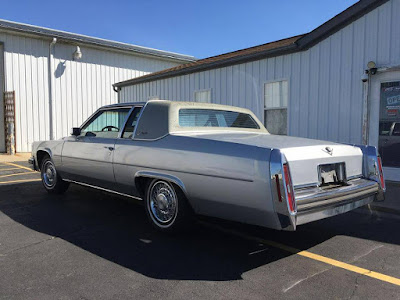It took my moving away from Greater New York to understand the obvious that "New York" is different from the rest of the country. One of many differences is middle America's love of pickup trucks. Back where I come from no one owned one who really didn't need one. Here in Cleveland, Ohio, which is a microcosm of everything good and bad in this country "between the coasts", folks who don't even need pickups buy them; for reasons that still escape me. A prime example of that mid-American love of pickups is this 1953 Ford F100 that's been sliced, diced, hacked, welded and chopped into something that would have Crazy Henry spinning in his grave.
Every car or truck has a story and it's safe to say that the actual story can't be as interesting as what you think it would or could be. I have no idea why someone with the welding, soldering and fabrication chops that this person has, not to mention their mechanical acuity, would morph this old Ford so it could be "resto-modded" with a Chevrolet V-6. Obviously, based on the cataloging of the build, it was done on purpose. Again, the reasons why have to pale in comparison to why we think this was done.
Every car or truck has a story and it's safe to say that the actual story can't be as interesting as what you think it would or could be. I have no idea why someone with the welding, soldering and fabrication chops that this person has, not to mention their mechanical acuity, would morph this old Ford so it could be "resto-modded" with a Chevrolet V-6. Obviously, based on the cataloging of the build, it was done on purpose. Again, the reasons why have to pale in comparison to why we think this was done.
Rather than mull about the why, the facts are this person merged a 1985 Chevrolet S-10 with a 1953 Ford F100. They didn't just modify the frame of the F100 to hold the big Chevy V-6 either. They took about every mechanical bit they could from the S-10 and morphed the ladder frame of the Ford so that everything could bolt in or on. While spectacular, this build does beg the question about why Ford Ranger components of this vintage weren't used. Given a choice, I would have swapped the S-10 guts into a Chevrolet 3100 of the same era but that's me, Chevy guy at heart.
My "blue collar" genes throbbing with envy not so much because I want this truck but because, deep down inside, I want to be able to do stuff like this. And do it right. That's not to say this wasn't done "right" although I'd have kept it as much Ford as possible. Chevy and Ford folks get as testy about their vehicles as the Hatfields and McCoys did fighting over whatever it was they were fighting over. This would be fine as a vehicle for the farm, or what they call in the Dallas area a "deer lease", but if you're going to try and sell it, and for as much as $7,500, fans of either are probably going to have an issue with this.
I've expressed to my family my won ton desire to own a small, regular cab, short bed pickup. While I happen to really like their proportions, regardless of make, I'd like to have one not so much as a daily driver but so I can do "stuff". We could then get rid of our aging Chevrolet Tahoe while not sacrificing any of its wonderful practicality. They look at me like I have three heads, of course. My wife, in particular, taking me down to earth reminding me that Lowes and Home Depot offer perfectly good pickups to rent for like $20 an hour.
New York might be different from the rest of the country but the Midwest apparently is rubbing off on me. The Craigslist listing for this is gone but if it pops up again I'll update this. This guy was asking $7,500.











































